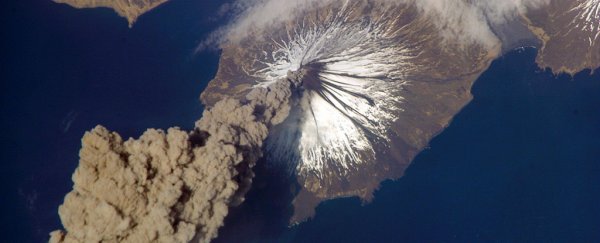Mount Cleveland looks like the kind of volcano you made for a grade four science project and filled with vinegar and bicarb. More geological zit than powder keg, it pops and oozes every decade or so to thicken its igneous skin.
There are five more like it nearby, making up what's known as the Islands of Four Mountains. Today, most of them are quiet. But geologists are wondering if together this innocent cluster of volcanoes far from the Alaskan mainland represents something far more Earth-shattering.
Researchers from institutions across the US are set to make their case at the at American Geophysical Union (AGU) 2020 Fall Meeting, arguing that the mountains Cleveland, Carlisle, Herbert, Kagamil, Tana, and Uliaga are all tips of one big magma chamber.
Cone-like stratovolcanoes can blow their tops in impressive ways but tend to emerge from relatively small to modestly sized pockets of magma.
A caldera is a collapsed chunk of crust formed by the collapse of a magma chamber as it empties. Such a collapse can be a relatively subtle sinking of rock crumbling into an empty hole. Under the right conditions, bubbles of gas get caught in the viscous molten rock, forming a pressure cooker that sends rock flying when it erupts.
There's no single smoking gun as far as evidence of a hidden caldera here goes, but there are plenty of hints. The make-up of certain gases escaping Mount Cleveland, for instance, and the way vents on several of the mountains align point to the possibility that a significant chamber lurks deep underground.
"We've been scraping under the couch cushions for data," says Diana Roman of the Carnegie Institution for Science in Washington, DC.
"But everything we look at lines up with a caldera in this region."
If their predictions are right, Alaska's Aleutian Arc – the line of islands stretching across the Bering Sea towards Russia's coast – could be harbouring a monster on the scale of Yellowstone's mighty supervolcano.
The entire chain contains around 80 volcanos in total. Dozens of them have erupted repeatedly in recent history, too, so it's no secret that it's a geologically active part of the planet.
One of the most active of the volcanos in the area, Mount Cleveland has erupted more than 20 times in the past two centuries. Some of them haven't exactly been small affairs, either, with one in 1944 ranking at a 'catastrophic' level three on the volcanic explosivity index (VEI).
If a hypothetical supervolcano below were to let rip, the world would know about it. At an 8 on the VEI, the material blown into the atmosphere would affect the global climate for years to come.
Just over two thousand years ago another Aleutian Arc volcano, Okmok, erupted with such ferocity it's speculated that the resulting changes to the climate half a world away could have been the final nail in the coffin of the Roman Republic.
The caldera beneath the Islands of Four Mountains promises a much bigger display.
As concerning as it all sounds, there are plenty more data to gather before we can sound any alarms.
"Our hope is to return to the Islands of Four Mountains and look more closely at the seafloor, study the volcanic rocks in greater detail, collect more seismic and gravity data, and sample many more of the geothermal areas," says Roman.
Even if confirmed, it'll take time to build a clear understanding of the caldera's workings. Yellowstone's supervolcano is located in a rather convenient spot for geologists, providing plenty of data all year round. And we're still debating just what's going on deep below Earth's skin.
Still, thoughts of apocalyptic explosions aside, knowing Mount Cleveland is tapping into a caldera could help volcanologists better understand the nature of its eruptions. With plumes pushing more than five kilometres (3 miles) into the air, there's the threat to air travel in that part of the world to think about.
"It does potentially help us understand what makes Cleveland so active," says lead author John Power, a researcher with the US Geological Survey at the Alaska Volcano Observatory.
"It can also help us understand what type of eruptions to expect in the future and better prepare for their hazards."
This research will be presented at the AGU Fall Meeting 2020.
